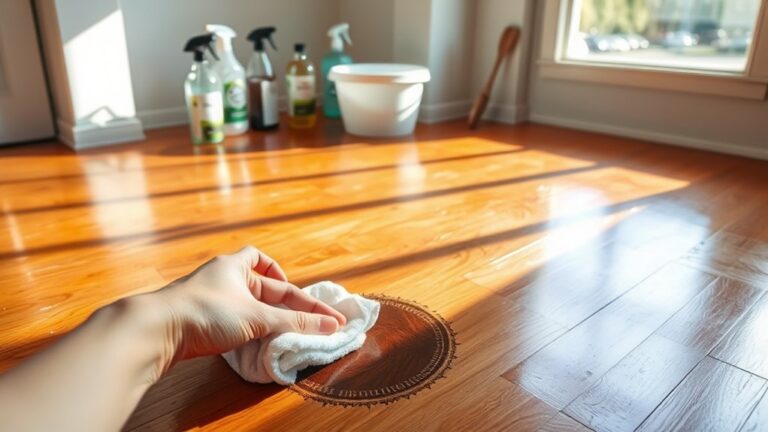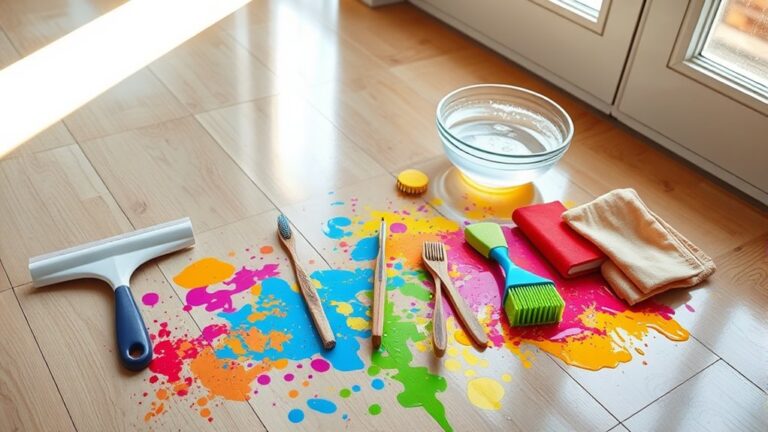First, quickly blot the dog pee with paper towels to absorb moisture without rubbing, which prevents deeper wood damage. Then gently clean the area with a damp cloth and apply an enzymatic cleaner to break down urine compounds and eliminate odor effectively. Avoid harsh chemicals that can harm your floor’s finish. Make sure the pavimento dries well and ventilate the room. Taking these steps promptly helps protect your hardwood. There are also tips and tricks for preventing recurring issues and maintaining your floor’s integrity.
Identify the Type and Extent of the Stain

Before you begin cleaning, you need to identify the type and extent of the stain. Stain identification is essential because dog urine can vary in composition, affecting how it interacts with hardwood floors. Check if the stain is fresh or has dried; fresh stains are usually yellowish and moist, while older ones may appear darker and more ingrained. Next, conduct a damage assessment by inspecting the wood for discoloration, warping, or soft spots. This tells you whether the urine has penetrated the finish or caused deeper damage, guiding your cleaning approach. Accurate stain identification and damage assessment empower you to choose the right method, preserving your hardwood’s integrity and maintaining your freedom from costly repairs.
Gather Essential Cleaning Supplies
To effectively remove dog pee from hardwood floors, you’ll need a specific set of cleaning supplies tailored to the task. Choose stain removers designed for hardwood to prevent damage. Gather cleaning tools that help you reach all affected areas efficiently. Having these essentials on hand guarantees a thorough and safe cleaning process.
| Supply Type | Recommended Items | Scopo |
|---|---|---|
| Cleaning Tools | Microfiber cloths, scrub brushes | For wiping and gentle scrubbing |
| Stain Removers | Enzyme-based cleaners, vinegar solution | To neutralize and lift stains |
| Protective Gear | Gloves, masks | To protect your skin and lungs |
| Absorbents | Paper towels, baking soda | For soaking and odor control |
With these supplies, you’re ready to maintain your hardwood’s integrity while freeing it from stains.
Initial Cleanup: Blotting and Removing Excess Urine

Start by immediately blotting the urine with paper towels or a clean cloth to absorb as much liquid as possible without rubbing it into the wood. Next, use a damp cloth to gently remove any remaining residue, ensuring you don’t saturate the floor. Acting quickly and carefully will prevent urine from seeping deeper and causing lasting damage.
Immediate Blotting Techniques
Act quickly to blot the urine with a clean, absorbent cloth or paper towel. The key to preventing stains and odors is to soak up as much liquid as possible without rubbing, which can spread the urine deeper into the wood. Use blotting techniques by gently pressing down to let the absorbent materials draw out moisture. Replace the cloth or towel frequently to maintain effectiveness. Avoid scrubbing or wiping, as this can damage the finish and push urine further into the grain. Working methodically, start from the outer edges of the spill and move inward to contain it. Immediate blotting techniques minimize damage and set the stage for thorough cleaning. By acting fast and using proper absorbent materials, you preserve your hardwood floors’ integrity and enjoy lasting freedom from stains.
Removing Urine Residue
Once you’ve absorbed as much liquid as possible, the next step focuses on removing any remaining urine residue from the hardwood surface. Start by gently cleaning the affected area with a mixture of mild soap and water, avoiding excess moisture to protect your floor’s finish. Then, apply effective urine neutralization techniques, such as a solution of white vinegar and water, to break down odor-causing compounds. Let it sit for a few minutes before wiping it away with a clean cloth. For stubborn stains, enzymatic cleaners designed for hardwood floor care can be particularly effective, as they target organic matter without damaging the wood. Always test cleaning solutions on a hidden spot first to verify compatibility. This methodical approach helps maintain your hardwood’s integrity while freeing you from lingering odors.
Using Enzymatic Cleaners for Effective Odor Removal
Although traditional cleaning methods can remove visible stains, they often leave behind odors that linger; using enzymatic cleaners is a more effective way to eliminate both the smell and the source of dog urine on hardwood floors. These cleaners break down organic compounds, providing enzymatic benefits that neutralize odors rather than masking them with fragrances.
Here’s a quick guide:
| Fare un passo | Azione | Risultato |
|---|---|---|
| Apply Cleaner | Spray directly on stain | Targets urine molecules |
| Let Sit | Wait 10-15 minutes | Enzymes break down odor sources |
| Wipe & Dry | Use clean cloth, air dry | Leaves floor odor-free |
Using enzymatic odor neutralizers guarantees your hardwood stays fresh, freeing you from persistent smells and helping maintain your floors naturally.
Homemade Remedies for Treating Dog Urine Stains

If you prefer using ingredients you already have at home, several effective remedies can help treat dog urine stains on hardwood floors. Start by blotting the area to remove excess moisture. Then, apply a vinegar solution—mix equal parts white vinegar and water—to neutralize odors and act as a natural urine neutralizer. Let it sit for 5-10 minutes before wiping it dry. For tougher stains, sprinkle baking soda over the area after the vinegar solution, then spray lightly with water. Allow it to dry completely, then vacuum to remove residue. These homemade approaches target both the stain and odor without harsh chemicals, preserving your floor’s integrity while giving you control over the cleaning process. Remember, prompt treatment is key to preventing permanent damage.
Preventing Damage to Your Hardwood Floor Finish
Addressing dog urine stains quickly helps minimize damage, but protecting the finish on your hardwood floor goes beyond stain removal. To guarantee lasting floor protection, implement preventive measures such as applying a high-quality polyurethane sealant. This creates a barrier that resists moisture and prevents urine from penetrating the wood. Additionally, consider using area rugs or mats in spots your dog frequents to reduce direct contact with the floor. Regularly trim your dog’s nails to avoid scratches that can compromise the finish, allowing liquids to seep in. Finally, maintain a consistent cleaning routine using hardwood-safe products designed to preserve the protective coating. By combining these preventive measures, you safeguard your floor’s finish and maintain its natural beauty without sacrificing your freedom to enjoy your space with your pet.
Drying and Ventilating the Affected Area
Once you’ve cleaned up the dog urine, it’s crucial to thoroughly dry and ventilate the affected area to prevent moisture from seeping into the wood and causing long-term damage. Start by using absorbent towels or microfiber cloths to blot excess liquid, applying consistent pressure without rubbing. Employ drying techniques such as placing a fan nearby to increase air circulation, or using a dehumidifier to pull moisture from the air. Open windows and doors if possible, following ventilation tips that encourage cross-breezes to speed up drying. Avoid using heat sources like hairdryers directly on the floor, as excessive heat can warp the wood. By methodically applying these drying techniques and ventilation tips, you’ll protect your hardwood floor’s integrity and maintain its natural beauty.
Tips for Preventing Future Accidents on Hardwood Floors
Properly drying and ventilating the area after cleaning helps prevent damage, but stopping future accidents is the next step in protecting your hardwood floors. Start with consistent dog training to establish clear bathroom routines. Use positive reinforcement to encourage your dog to relieve itself outdoors or in designated areas. Behavior modification techniques can correct unwanted habits—redirect your dog promptly when you notice signs of accidents. Consider crate training to limit unsupervised access to hardwood areas. Clean any accidents immediately with enzymatic cleaners to eliminate odors that might attract repeat behavior. Additionally, placing mats or rugs in high-risk zones provides a protective barrier. By methodically combining dog training and behavior modification, you’ll secure your floors and grant your dog the freedom to learn appropriate habits without compromising your home’s integrity.




